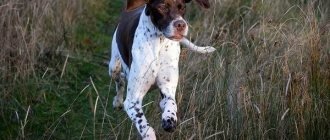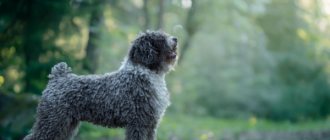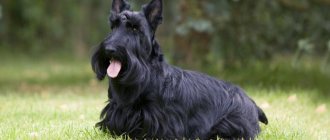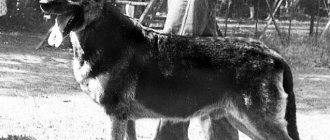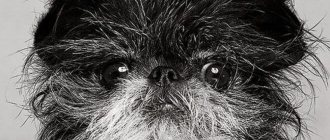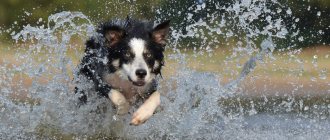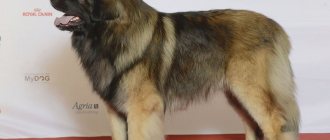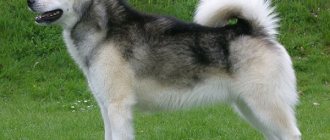History of Welsh Terriers
The pedigree of the breed goes back to the 17th century, when wire-haired black and tan terriers roamed the fields of English Wales. Initially, the cocky, loud-voiced dogs were bred by farmers who needed compact animals that combined the “qualifications” of guards and rat catchers, but at the same time were content with a ladle of liquid stew. Subsequently, several new breed lines sprang from Welsh dogs, including the Welsh family.
Over time, the line of the Old English Black and Tan Terrier died out, giving way to more tenacious and agile descendants. Perhaps that is why, from the middle of the 19th century, increased attention began to be paid to “pumping up” the external and working qualities of Welsh Terriers - by 1886, the breed already had its own standard, and pages in stud books, and a club of admirers. The descendants of Welsh rat catchers came to Russia after the Great Patriotic War, but did not arouse any professional interest among dog breeders. As a result, the shaggy “emigrants” lived ordinary, unremarkable lives as pets, leaving no purebred offspring behind.
The real breeding of Welsh Terriers in the USSR began in the 70s, when breeding animals were brought to the country from abroad. At that time, the domestic stock came from foreign sires Glaya-Erik, Axel, Glory-Mercy and Yudita-Yozho, so the breeders soon faced a shortage of fresh genes - all the animals bred by Soviet breeders were closely related to each other. Fortunately, already in the 80s the problem was solved by importing pedigree Welsh Terriers from Sweden, Germany and Finland, which significantly improved the external performance of Russian breed lines.
Video
* We invite you to watch a video about the Welsh Terrier . In fact, in front of you is a playlist in which you can select and watch any of 20 videos about a given dog breed by simply clicking on the button in the upper right corner of the window. In addition, the material contains quite a lot of photos. By looking at them you can find out what a Welsh Terrier looks like.
In this article:
|
Rate the material!
[Total votes: 2 Average: 5]
Breed standard
When you first meet a Welshman, you really want to write him down as a relative of the Airedale Terrier - the same shaggy rectangular face, the same coarse hair on the body and the same hunting bearing. In fact, the only common ancestor between the breeds is the Old English Black and Tan Terrier. At the same time, representatives of both families have never been crossed with each other, not to mention the working specializations, which are completely different between the Welsh and the Airedale. In particular, the Welsh Terrier has always been “sharpened” for burrow hunting, while its competitor from Yorkshire more often practiced catching river otters.
Head
Welsh Terriers have a flattened, moderately wide skull, a harmoniously developed but not excessively long muzzle and a distinctly smooth stop.
Teeth and jaws
Strong, strong teeth meet in a scissor bite. The massive, well-defined jaws have good depth.
Nose
The lobe is neat, painted in a uniform black tone.
Eyes
Welsh Terriers are characterized by small almond-shaped eyes without obvious bulge and roundness.
Ears
The Welsh have elegant, high-set ears: medium-sized, regular V-shaped, tightly fitting to the temples.
Neck
The Welsh Terrier's neck has a slight graceful curve and flows smoothly into the shoulders. The neck muscles are developed, but not excessively.
Frame
The Welsh Terrier is a compact dog. The animal's back is short, with a strong loin; The chest is moderately wide and deep.
Limbs
Welsh dogs have strong, even legs with low-set hocks, providing the animal with a free, energetic reach and linear movement. The dog's shoulder blades are long, strongly laid back; the pasterns are powerful and straight, and the elbows move freely along the body. The hind legs look massive due to the muscular elongated thighs, while the paws have a miniature cat shape.
Tail
Historically, Welsh dogs, like all terriers working in burrows, had their tails docked. Today this procedure is prohibited by European associations, therefore modern representatives of the breed have high-set tails of normal length, carried vertically (the so-called funny tail is considered a defect). If the tail is docked, which is still common in Russia, its tip should not be higher than the occipital protuberance of the pet.
Wool
The slightly disheveled "clothes" of the Welsh Terrier consist of undercoat and wiry, coarse hair. At the same time, the layer of wool is very dense, not lagging behind the animal’s body.
Color
The Welsh Terrier can be black and tan or must have a “coat” of black grizzly and tan color. At the same time, black markings on the toes are prohibited, and black coloring below the dog’s hocks is also not desirable.
Defects and disqualifying defects in appearance
Disadvantages of the exterior include excessively large dimensions (height above 39 cm at the withers), hare-like paws, anatomical deviations from the standard (long/sloping croup, belly, weak withers, etc.). The ban on exhibiting in the ring applies to Welsh Terriers with cryptorchidism, depigmented lobes, lips and eyelids, atypical colors and coat structure, as well as cowardly and overly aggressive dogs.
Choosing a puppy
Before buying a puppy of this specific breed, you need to answer yourself:
- How great is the desire to keep a Welsh Terrier in the house/yard.
- For what purpose is a dog purchased?
- Is the future owner ready to invest most of his time and effort in raising the dog?
If the desire to have a Welsh Terrier is really great and justified, you should listen to the advice of dog handlers, among whom there is an opinion that a Welsh Terrier dog is more like a monkey with a grenade. It is almost impossible to guess which instinct is driving the dog at the moment and where it will turn. Even despite its small size, the grenade is also small.
As for the purpose of acquisition, each person has his own:
- A soul dog is a category of those who are not the first to have a Welsh dog.
- Star dog – purchased for a show career. More your own than the dog's. There is a whole iceberg of relationships between dog and owner.
- For hunting purposes. Dogs are purchased by practicing hunters.
- For the purpose of participating in sports competitions. Welsh dogs are indeed considered talented participants in competitions in agility, offense, and Frisbee.
- Purchasing a dog for breeding purposes.
It is extremely rare to find a combination of all five points in one representative of the Welsh Terrier breed, the price of which will be insanely high. Yes, and you can meet such a dog in an extremely rare case, and then only in adulthood. How much effort was put into raising him, ask the owner of that Welshman.
To choosing a puppy. The main thing is that the dog is adequate. Therefore, it is worth getting to know the parents of the litter. Breeders who respect themselves and their own reputation do not allow dogs with psychological defects or deviations to be bred.
The puppy should be active and cheerful. Ears and eyes are clean. The baby should be well fed, but the stomach should not be swollen, which may indicate the presence of worms. The coat of a small Welshman should be silky, without bald patches. The body is clean, without dermatitis or signs of irritation. Puppies are provided with a birth certificate and a veterinary passport with the dates of vaccinations, sealed with wet seals.
The puppy's black and tan color changes color only when the dog is two years old.
Temperament of the Welsh Terrier
Welsh is perhaps one of the most “terrier” representatives of his own group. Infinitely expressive, passionate, and in relation to other animals also incredibly cocky, this comrade strives to be on time always and everywhere. When acquiring a breed for home keeping, you should not give in to its hunting past: Welsh Terriers do not rush at children and do not show aggression towards adults. The only thing you will have to get used to is the willfulness of the agile nimble. A true Welsh Terrier has his own vision of any everyday situation and his own system of judgment, so it can be difficult to convince him.
The breed cannot imagine life without close contact with the owner. To be more precise, Welsh dogs are generally ready not to part with their owner for days: a terrier resting its head on a person’s slipper or leg and falling asleep in this position is a completely common picture. By the way, if you dream of a pet that can “mimic” the color of the wallpaper, you are definitely not in the right place with Welsh terriers, because you can always see and hear them in the apartment. It’s also difficult to hide anything from Welshies, so when you acquire a representative of this family, prepare to be “under the guard” of your pet every minute.
The Welsh Terrier does not get along with other dogs: this is a fact that needs to be accepted. In addition, he is the greatest provocateur, knowing how to arouse hostile interest on the part of shepherd dogs, wolfhounds and other large-sized tribesmen, famous for their ferocity. However, the dog does no better with small representatives of the fauna - cats, hamsters and rats, when they see a Welsh dog, run away at jet speed. The Welsh Terrier loves to have tough showdowns with creatures even slightly smaller than him.
A modern purebred Welsh Terrier is almost always a gambling addict. Don’t think that you have completed your mission by taking your dog outside and making him run after a ball. Upon returning home, the shaggy “meteor” will continue to demand a new portion of entertainment. He does this not impudently, but in the manner characteristic of terriers, that is, every minute he lies in wait for the owner who is distracted from business and reminds him of his own existence. Toys scattered around the house are another cunning way to catch a person in your net. As soon as you kick a squeaker that has turned up under your foot, the Welshman will regard the sound made by the toy as a signal to action, and then he will not be able to get away from the game.
Character and habits of Welsh Terriers
Welsh Terriers are loyal protectors and loving companions. They have a reserve of energy and curiosity that lasts until old age. Representatives of this breed are hardy, brave, and ready to rush into battle at any opportunity. Because of this, some Welsh Terriers are aggressive towards dogs of other breeds, but with proper training there will be no aggression.
Unlike other, larger varieties of terriers, Welsh terriers are much calmer and more balanced. But due to their hunting instincts, they tend to hunt small prey: squirrels, birds, shrews. Without proper supervision, the dog will quickly pursue the intended prey. Hence the habit of some representatives of the breed to dig the ground.
Welsh Terriers get along well both in a country house and in an apartment. But due to their natural activity, they need frequent walking and physical activity. These pets are suitable for people who play sports or have older children. Welsh Terriers willingly play with children, but you should not leave them with very young children.
In general, the breed is peaceful and rarely shows aggression, but if push comes to shove, the Welsh Terrier shows all its hunting power: their grip is very difficult to separate. Thanks to these qualities, country houses will be protected from rats and other rodents, as well as from attacks by uninvited guests. However, it is worth remembering that the Welsh Terrier is a small breed of dog.
Welsh Terriers are highly wary of strangers. Therefore, the dog will look closely at each guest, not taking his eyes off him. If the dog is not given proper attention, the dog will begin to get bored and display destructive behavior. Therefore, this dog requires regular attention from the owner.
Education and training
The Internet is full of funny videos, the heroes of which are terriers, turning on coffee makers, brushing dust from furniture with a broom and polishing the owner's shoes to a shine. However, it is important to understand that behind such shows there are months, even years of hard work. In ordinary life, Welsh dogs, like all representatives of the terrier group, are not eager to learn and do not tolerate being forced to acquire knowledge. Therefore, the only way to interest a dog in training is to put it in a playful form. The main thing is that the four-legged scoundrel does not see through the trick and does not guess that serious work lies behind the supposed entertainment. Positive incentives can also work wonders. Welsh Terriers are greedy for praise and are easily tempted by treats.
When raising a puppy, it is necessary to adhere to moderate firmness. From the first days of being in the house, the baby must understand the system of prohibitions and then strictly follow it. At first, the Welsh Terrier will try to defend its own rights. For example, he will whine resentfully when he cannot lie on the bed, or he will begin to hypnotize with his gaze every piece that a person puts into his mouth. It is important not to be fooled by provocations and not to meet the dog’s weaknesses. Any permissive action for an animal is identical to a small victory that is worth securing. As a result: today you fished a piece of meat out of your own plate for the Welshman, and tomorrow your pet will jump onto your lap to take the treat from the table on its own.
Train your puppy to come when asked in a timely manner. By three to four months, the Welsh Terrier should respond to the owner’s call, and the animal can be controlled either with the standard command “Come to me!” or simply by pronouncing the nickname. However, you should not abuse trust, so if an animal has done something wrong, calling it for punishment is a grave mistake. Welsh is not a stupid creature and will quickly figure out what awaits him in such cases, so next time he will either skillfully feign deafness or hide from punishment.
If the Welsh Terrier begins to make attempts to dominate, they must be stopped sharply, but kindly. For example, if the dog decides to grumble in response to demands or after the command “Sit!” jumps off abruptly, you can shake it thoroughly or press it to the floor with your hand.
Important! Do not follow fashion trends and do not train your Welshie using an electric collar. This is a very painful accessory for the animal, which in the future can harm the already sensitive neck of the Welsh Terrier.
To toilet train your Welshman, take him for walks more often. Puppies do not know how and cannot endure for long, so it is important to have time to take the baby out before he has time to make a puddle (immediately after sleeping or eating). If your ward did not make it to the walk and left waste products on the floor, do not scold or spank him. The puppy will decide that going to the toilet in your presence is the height of bad manners and next time he will relieve himself in a secluded corner of the apartment. In general, as Welsh Terriers age, they quickly realize that it is more convenient to satisfy their toilet needs outside and look forward to their next walk.
It is better to do ring training for your pet in secluded places where there are no dogs or other people. This will make it easier for the Welsh Terrier to concentrate on commands. Usually training begins with running (commands “Lynx!”, “Work!”). If the animal moves incorrectly and goes into a gallop, it should be pulled back (command “No!”). From straight-line movements you can move on to running in a circle, which is a more complex action. Commands “Ring!”, “Inspection!”, “Teeth!” are introduced after the Welsh Terrier has learned to move at the correct trot.
History of the breed
The Welsh Terrier's homeland is Great Britain, or more precisely, the county of Wales. This breed appeared in the second half of the eighteenth century. Refers to hunting dogs.
The Welsh Terrier is surprisingly similar to the Airedale Terrier. Uninformed people call the Welsh Terrier its smaller copy. This statement is incorrect; no common roots can be traced between these breeds.
The history of the origin and formation of the breed can be traced through ancient records, paintings, and figurines.
In ancient times, a terrier was the name given to any small dog that had a vicious character, strength, coarse hair, and hunted small predators, rats and mice with amazing dexterity.
The Welsh Terrier is descended from the Old English Wirehaired Terrier, which is now an extinct species. For a long time, at exhibition shows, the Welsh Terrier was classified as an Old English Terrier. But many other types of terriers fit into this category.
By 1885, the Welsh Terrier was fully formed and received a separate classification in the Kennel Club of England. Since that time, purebred breeding began and official Welsh Terrier nurseries appeared.
The popularity of the Welsh Terrier began to grow. He became famous outside his homeland. They began to breed it in America and European countries. In Germany, breeders used Welsh Terrier genes to develop a breed such as the Jag Terrier.
There is an assumption that during the formation of the Welsh Terrier, dog handlers involved fox terriers, Lakeland terriers, and Irish terriers in breeding work.
Hunting with a Welsh Terrier
In Russian realities, you can successfully fight a fox with a Welsh dog. The breed is distinguished by good viciousness and fiercely attacks the animal in a hole. However, it is better not to count on lightning success, since seasoned foxes can lead a dog by the nose for a long time, winding through underground tunnels. It usually takes Welsh Terriers several hours to wear down a red rogue and drive it out at gunpoint. The process is especially delayed if the hole is old and branched.
The situation is even more complicated with badger holes, which are sometimes occupied by fox families. It can be difficult for a Welsh dog to navigate this semblance of the Parisian catacombs and often, after being active for several hours, the dog loses interest in the enemy. That is why, when buying a puppy for hunting purposes, it is important to ask the seller how high the degree of viscosity is in the baby’s parents. This quality, like malice towards the animal, is inherited and even an experienced professional cannot easily cultivate it.
In Europe and America, classic hunting is not favored, preferring to replace it with bloodless entertainment. For example, in the USA, Welsh Terriers are used in the sport of barn hunting. The essence of the attraction is to imitate hunting actions using a labyrinth built from straw bales, in which cages with rats are placed. A Welsh Terrier released into a hole must find rodents in the shortest possible time and inform the owner about this.
At the moment, barn hunting is recognized as an official sport by several canine associations. In addition, it does not establish class boundaries for participants (both show pets and pet-class Welsh dogs can compete). In Russia, such “quests” are not yet common, although some pioneers have already built straw labyrinths on their plots, where they successfully train Welsh Terriers and their relatives.
Description and character of the Welsh Terrier breed
More than 400 years ago, a breed of wire-haired terrier with a black and tan color was widespread in Wales. This breed is the real progenitor of the Welsh Terrier. At that time, these dogs were intended to catch rats and other small rodents, as well as to protect land. It is interesting that in those days rat-killing competitions were very developed, where terriers had the opportunity to show their amazing qualities and demonstrate excellent battle tactics. By the way, the Welsh Terrier dog inherited this feature from its ancestors and today can demonstrate it perfectly.
The year 1886 was marked by the opening of the first Club of Welsh Terrier Admirers, and at the same time the standard for this breed was approved. 13 years later, at a dog show held in Liverpool, breeders presented 93 examples of beautiful dogs of this breed. In Russia, the Welsh Terrier breed became widespread only in the 70s of the 20th century. It is no wonder that she immediately gained great popularity, since keeping her in a small apartment is not difficult.
The Welsh Terrier can describe the breed in a few words - it is a cute, cheerful dog with whom you will not be bored.
This breed is considered ideal for men, since a small pet is capable of performing a variety of functions - entertaining throughout life, lying down for a long time without constant attention, amusing with curiosity, and, of course, protecting the abode. In addition, she can be an excellent company while hunting.
Characteristics of the Welsh Terrier breed:
- 39.5 cm height;
- 9-9.5 kilogram weight;
- Flat skull;
- Black nose;
- Powerful jaws;
- Deepened eyes;
- Drop triangular ears;
- Slightly arched neck, medium length;
- Short back;
- Deep chest;
- Strong lower back;
- Tail set well;
- The front legs are muscular and straight;
- The hind legs are slightly curved;
- Cat's paws;
- Wire-like thick coat;
- Red-brown color.
The Welsh Terrier is a very peaceful and cheerful breed. She especially enjoys games involving the whole family. The pet gives its main love to children, considering them its friends and partners. The Welsh Terrier will happily help dig up newly planted flowers in the garden and dig holes everywhere, wanting to help the owner with work in the garden. However, in addition to such friendly pranks, the baby will happily help you choose the ripest vegetables and fruits, since it has such a convenient quality.
The Welsh Terrier dog breed loves to chase cats around the yards, so you should not dream that he will get along with them under the same roof. These dogs are very peaceful, so you rarely see them in an aggressive state and fighting with other dogs. However, the mood changes when danger appears. This little friend is able to repel the villain and defend his beloved family with honor.
The curiosity of Welsh Terriers knows no bounds, so they must be trained
Otherwise, an overly interested pet will not respond to the owner’s call signs, and even less will not follow his commands, since all attention will be directed to the object of interest.
Maintenance and care
The Welsh Terrier puppy is a little energizer with an insatiable passion for mischief and destruction, so before moving the baby to a new home, make sure to buy space limiters. These can include dog cages, indoor enclosures and other structures that do not allow the animal to escape beyond the designated area. Of course, the pet should not spend days in this kind of cell, but when leaving home even for a short period of time, it is wiser to protect the Welsh Terrier from itself by limiting its area of movement.
It is better to use old textiles as bedding in the cage, rather than newspapers, which Welshies can chew for fun. On hot summer days, Welsh terriers are not averse to cooling off in a pond, so if there is none nearby, you can arrange an artificial pool for your dog right in the yard by filling a flat, shallow container with water.
Make sure to purchase the correct collar and leash and take your Welshie out into busy streets where other dogs meet, in full walking gear. Remember that Welsh Terriers react very violently to even minor provocation from their four-legged pets. When keeping a dog in the yard of a private house, be responsible when choosing a fence. The Welsh Terrier is extremely jumpy, not to mention the fact that this comrade manages to dig under a fence in a matter of minutes.
Interesting facts about Welsh Terriers
Welsh Terriers are active dogs with a willful character. They are often cocky and do not miss the opportunity to make a scandal or have fun. They love to be the center of attention and are not ready to share primacy in the family, even with children. In addition, Welsh Terriers have a number of interesting qualities that everyone can appreciate in their own way.
Welsh Terrier dog breed is quite actively used by hunters as universal dogs. The Welsh Terrier can grab prey, drive it into a corner, bark, or bring back a bird that has already been shot. These dogs are indispensable for hunting. Some hunters note that some dogs are better at hunting badgers, while others are better at hunting foxes. In terms of hunting, they resemble German pinschers.
At the beginning of their existence, Welsh Terriers were used as hunters for burrowing small animals. Subsequently, their use became wider, and guarding and shepherding qualities appeared. Today, representatives of the breed have become excellent companions for people. They are deservedly included in the TOP 10 small hunting dogs.
Welsh Terriers are always in high spirits. They are ready to play and have fun, despite their elegant, aristocratic appearance. Welsh Terriers need a proper training program. This way you can protect the furniture in your house from the constant attacks of these active dogs, and also allow the breed to develop competently. Training is not very difficult, but it needs to be done.
Hygiene
Conditioned shedding is something that happens to Welsh Terriers twice a year. The breed does not shed its fur completely, so in order for the coat to be renewed, the owner will have to engage in trimming (plucking the fur) or entrust the process to an experienced groomer. The first trimmings begin in puppyhood: at three to four months of age, it is time to teach the Welshman to calmly endure an unpleasant procedure for him. If you plan to apply the shine yourself, buy grooming tools: knives with fine, medium and coarse notches, mucrackers and other auxiliary items, including brushes and tangle cutters.
Before pinching the Welsh Terrier, it is necessary to comb it along the growth of the coat and against it, simultaneously sorting out tangles, if any. In addition, you will have to prepare for the fact that you won’t get a stunning result right away. Keep in mind that a truly spectacular awn grows after several trimmings. At the same time, at first Welsh terriers have to show off almost naked, since during the first plucking of the fur they have to remove all the dead hair down to the undercoat, which exposes the skin. Another problem that may arise in puppies and young animals is the hair on the neck and chest that does not want to shed. It is not recommended to be zealous and try to tear out the fur in such cases. Just comb these areas of the body daily and wait for the hair to begin to die off on its own.
For novice fans of the breed, when they first pinch, it is better to be guided by grooming diagrams, which are easy to find on the Internet. They clearly illustrate how to properly grip the hair and in what sequence to trim parts of the dog’s body. For example, the legs of a Welsh dog are almost never plucked down to the undercoat before an exhibition, since the limbs of show dogs must look like columns, otherwise the score in the ring will be reduced.
Important! Show dogs are plucked a couple of months before entering the ring, and this requires special, more thorough trimming. If you are not yet able to properly “cultivate” the Welshman, it is better to entrust the show plucking to a groomer, after carefully studying his portfolio.
Caring for the ears, eyes and mouth of a Welsh Terrier is not difficult, but it is necessary. The most important thing is timely examination of the hearing and vision organs, as well as their hygiene. Wax from the ear funnel is removed with a clean cloth soaked in hydrogen peroxide, chlorhexidine or miramistin. Dust lumps from the eyes can be removed with a clean napkin in the morning, and once a week it is useful to wipe the mucous membrane of the eyelid with cold tea or chamomile infusion. About once every three days you will have to arm yourself with a toothbrush and toothpaste for dogs to treat your pet’s mouth. The process is not complicated, given that veterinary pastes do not foam and there is no need to rinse the Welshman’s mouth with water afterwards.
Welsh Terrier nutrition
The owners of Welsh Terriers are lucky: they will have a pet that is not picky about food living in their home. The dog's strong teeth will allow him to cope with any food. During periods of increased physical activity, the amount of feed can be increased. Like any dog, the correct ratio of proteins, fats and carbohydrates in the diet is important for the Welsh Terrier.
Since the body converts excess carbohydrates into fat, their amount in the daily feed depends on many factors. Among them are the dog’s weight, its mobility, which is influenced by the conditions of detention and the degree of workload, the condition of the coat, time of year, whelping or feeding period, age and gender.
On average, the normal functioning of a dog will be ensured by the following daily doses per 1 kg of live weight: 3-4 grams of proteins, 1-2 grams of fats and 12-15 grams of carbohydrates.
Every day your dog should consume proteins (protein), fats and carbohydrates. A balanced diet consists mainly of animal products (meat, dairy products, fish) with the addition of cereals, flour and small amounts of greens and root vegetables.
Proteins are involved in the construction of new body cells, fats serve as a source of heat and part of the protoplasm of cells, affect digestion and ensure cellular metabolism. Carbohydrates also take part in metabolism, almost all body tissues are made up of them, and they are also a source of energy.
The dog's body digests meat and meat products best - this is the basis of their diet. At least once a week, the dog should receive raw meat - half the daily requirement.
Cereals (crushed oatmeal, millet, buckwheat, pearl barley, barley) are always fed to dogs in porridges. Oatmeal and millet cereals are best suited. A dog's diet can include quite a lot (200-300 grams per day) of bakery products: bread, crackers, flatbreads, etc. Bread is added to milk, soup, or given in its natural form. The crackers are pre-soaked.
Oatmeal, wheat and rye flour can fully replace the corresponding cereals. Boiled flour stew is prepared from flour, which is used occasionally, since dogs are reluctant to eat it. Flour dust is also fed to dogs. It is brewed in meat soup or boiled with milk if the dust is not clogged. Grain chaff, consisting of broken grain, without the seeds of weeds and harmful plants, is used for feeding dogs in peeled, peeled, ground and boiled form. It is less nutritious than whole grains.
Peas, beans, lentils, and corn are used to feed dogs in ground, finely crushed form after long cooking, mixed with other cereals.
Feeding
Typically, mixed and dry types of feeding dogs are preferred by breeders who regularly attend international exhibitions - while on the move, feeding a pet with natural dishes becomes troublesome. Breeders of working lines, on the contrary, prefer animal proteins, cereals and fresh vegetables to industrial “drying”.
The traditional menu for an adult Welsh Terrier consists of lean meat, tripe and offal, which are added to buckwheat and rice porridge cooked in broth. Ocean fish fillets also add pleasant variety to the diet, as do fermented milk products, but such delicacies should not appear in a dog’s bowl every day.
Pumpkin and carrots seasoned with unrefined vegetable oil are used as vitamin supplements. Welsh terriers love salads like these if they are accustomed to them from an early age. Some individuals prefer heat-treated vegetables or sauerkraut - this is normal and acceptable. The main thing is not to try to replace animal protein with plant fiber.
Laminaria, fucus, and fish oil, which have no contraindications and are well tolerated by the dog’s digestion, can be an equivalent replacement for industrial mineral complexes. Homemade rye crackers or dried fruits are perfect as treats to reward an animal for success in learning and training. The main thing is that the latter are not from a store, where such products contain lethal doses of dyes, sugar and preservatives.
Breed dossier
1. Country of origin: Great Britain.
2. Classification: Group 3. Terriers. Section 1. Large and medium terriers.
3. Training. Welsh Terriers are active and willful dogs, they love training and games, but can be extremely stubborn and difficult to train. When raising this dog, you should show strength of character and endurance, because the Welsh Terrier loves to test the owner’s patience and stubbornly refuse to follow this or that command.
4. Color: black and white. The back is darker, brown or black, and the belly and limbs are red.
5. Dimensions. Height at the withers: males: 37 - 40 cm, females 33 - 36 cm. Weight: 9 - 10 kg.
6. General impression: a small dog of compact size, angular, rectangular in format. In appearance it is a bit like an Airedale Terrier.
7. Use: hunting dog, companion dog.
8. Physical activity: active. The Welsh Terrier is a very active and energetic dog breed that loves movement and communication. This dog happily brings his owner a ball, a stick, or a frisbee. It is best to walk this dog in nature so that it can get plenty of exercise. It is very good if you have the opportunity to send your Welsh Terrier to a special school where dogs are taught commands.
9. Character: active, energetic. Welsh Terriers require a lot of attention to their person. These dogs love to be the center of everyone's attention, so they are ready to play pranks all day long just to be looked at. Representatives of this breed are perfect for noisy families who lead an active lifestyle and are often outdoors. If raised incorrectly, a Welsh Terrier can become aggressive and embittered. This dog is characterized by pugnacity. The Welsh Terrier loves to get into fights with other dogs if he sees them fighting. He himself does not provoke anyone, but he is ready to bark and bite for company.
11. Grooming: labor intensive. The Welsh Terrier has a coarse coat of medium length; haircuts for this dog are contraindicated by the standard, because a regular haircut spoils the structure of this dog's coat. Instead of a haircut, a Welsh Terrier needs to be trimmed (specially plucked hair) twice a year. It is better to leave this procedure to a specialist.
12. Accommodation: average. Welsh Terriers can be aggressive towards other pets, and jealousy is also inherent in these dogs.
13. Diseases: eye diseases, skin dermatitis.
14. Diet: balanced.
15. Life expectancy: 12 – 14 years.
Photo: Welsh Terrier
How to choose a puppy
- Choose active, inquisitive puppies of medium size. Too small or large Welsh dogs are not the most enviable product.
- If you are looking for an animal with show and breeding potential, give preference to matured animals, since even a psychic cannot predict the show career of a two-month-old puppy.
- Pay attention to the degree of fatness of the litter. Welsh Terriers should not be thin or overfed.
- Find out what diplomas the producers of the offspring have. As a rule, parents with developed working (hunting) qualities have children with similar talents.
- There should be no white spots on the Welsh Terrier's coat. If the seller offers a Welsh dog with a white mark or mark on the chest, assuring that for animals of the pet category there is nothing wrong with this, do not give in to persuasion and refuse the purchase.
- Find out what vaccinations the puppies have received and what they eat. Responsible breeders feed their animals natural or super-premium dry food. If, while walking around the kennel, you come across a bag of Pedigree, do not expect to buy a healthy Welsh Terrier here.
Pros and cons of Welsh Terriers
Advantages of Welsh Terriers:
They are very hardy and agile. Dogs are able to run and jump for a long time, almost without getting tired. On walks, representatives of this breed give their best. In addition, they are very loyal watchdogs. The guarding qualities of this breed appeared relatively recently, but they managed to develop well. The Welsh Terrier senses its territory and is also wary of all visitors to the house.
Welsh Terriers remained hunting dogs. This means that they are suitable for both professional and amateur hunting. There will definitely be no rodents or other small pests in a private home, because a brave little hunter will voluntarily rid you of them. This is especially true for private houses in villages, where there is an abundance of all kinds of small living creatures.
Disadvantages of Welsh Terriers:
These dogs are not suitable for families with very young children. A moving hunting dog can accidentally injure a child. Also, Welsh Terriers do not tolerate being pulled or teased - it is easy to get them angry. In addition, Welsh Terriers are quite noisy and aggressive dogs if they are not raised properly.
They love to bark and get into conflicts with other animals, so keeping several dogs and, especially, cats at home will be problematic. Welsh Terriers need constant physical and mental exercise. Lack of activity traumatizes the animal’s psyche, and this will affect the health of the Welsh Terrier. This is a subjective minus; for active people it will be more of a plus.
Welsh Terrier price
Welsh Terriers are not as common in Russia as we would like, so you will have to spend time searching for a puppy of the right class. The cheapest offers on the market are representatives of working lines, which can be purchased for a modest 7,000-10,000 rubles. Usually these are puppies from producers who have achieved certain success in hunting, but are unremarkable in terms of exterior appearance. If you need a future star of exhibitions and dog shows, pay attention to registered nurseries like Siversky, which have been working with the breed for decades. For a baby with a decent pedigree and promising appearance in such places they ask from 25,000 rubles.
Breed characteristics
| Short description | |
| Origin: | England |
| Conditions of detention: | In a house, in a house with a garden, in an apartment |
| Purpose: | Hunting, companion |
| Color: | Brown with black or grayish-black shirt |
| Wool length: | Average 5-6 cm |
| Adult dog size: | The height of females is 34-38 cm, males - 35-40 cm, weight of males is approximately 10 kg, females - 9.5 kg |
| Average life expectancy: | 14-16 years old |
| Walk: | Once a day for 30-60 minutes |
| Physical activity needs: | Average physical activity needs |
| Fédération Cynologique Internationale (FIC) classification: | Group No. 3 terriers; Section No. 3 large and medium sized terriers |
| Puppy price: | From 10 to 30 thousand rubles. |
Origin story
Do you want to get a Welsh Terrier?
Yes
75%
While I'm thinking
25%
Has already!
0%
There is no reliable information about the origin of the Welsh Terrier breed. Presumably the ancestors were Old English terriers. There are common similarities between these dogs. Welsh Terriers were used for burrow hunting for small animals. Purposeful breeding of Welsh Terriers as hunting dogs began in the 19th century. The first breed standard was adopted in 1885; in our time it has remained without significant changes. The breed appeared in Russia in the second half of the 20th century, but is still not considered popular among domestic dog breeders.
